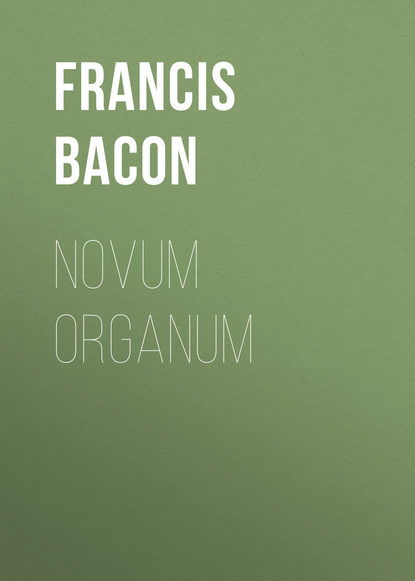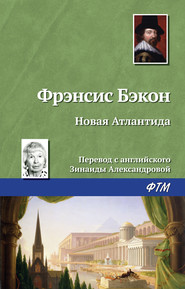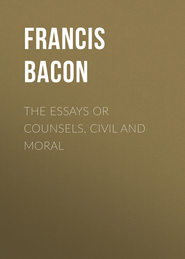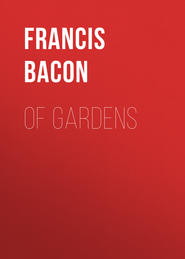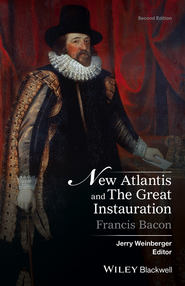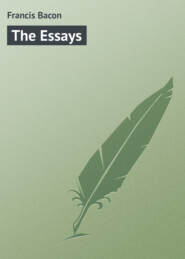По всем вопросам обращайтесь на: info@litportal.ru
(©) 2003-2024.
✖
Novum Organum
Настройки чтения
Размер шрифта
Высота строк
Поля
16. All bodies rubbed violently, as stone, wood, cloth, etc., so that rudders, and axles of wheels, sometimes catch fire, and the West Indians obtain fire by attrition.
17. Green and moist vegetable matter confined and rubbed together, as roses, peas in baskets; so hay, if it be damp when stacked, often catches fire.
18. Quicklime sprinkled with water.
19. Iron, when first dissolved by acids in a glass, and without any application to fire; the same of tin, but not so intensely.
20. Animals, particularly internally; although the heat is not perceivable by the touch in insects, on account of their small size.
21. Horse dung, and the like excrement from other animals, when fresh.
22. Strong oil of sulphur and of vitriol exhibit the operation of heat in burning linen.
23. As does the oil of marjoram, and like substances, in burning the bony substance of the teeth.
24. Strong and well rectified spirits of wine exhibit the same effects; so that white of eggs when thrown into it grows hard and white, almost in the same manner as when boiled, and bread becomes burned and brown as if toasted.
25. Aromatic substances and warm plants, as the dracunculus [arum], old nasturtium, etc., which, though they be not warm to the touch (whether whole or pulverized), yet are discovered by the tongue and palate to be warm and almost burning when slightly masticated.
26. Strong vinegar and all acids, on any part of the body not clothed with the epidermis, as the eye, tongue, or any wounded part, or where the skin is removed, excite a pain differing but little from that produced by heat.
27. Even a severe and intense cold produces a sensation of burning.[83 - “Ne tenues pluviæ, rapidive potentia solisAcrior, aut Boreæ penetrabile frigus adurat.”– Virg. Georg. i. 92, 93.]
“Nec Boreæ penetrabile frigus adurit.”
28. Other instances.
We are wont to call this a table of existence and presence.
XII. We must next present to the understanding instances which do not admit of the given nature, for form (as we have observed) ought no less to be absent where the given nature is absent, than to be present where it is present. If, however, we were to examine every instance, our labor would be infinite.
Negatives, therefore, must be classed under the affirmatives, and the want of the given nature must be inquired into more particularly in objects which have a very close connection with those others in which it is present and manifest. And this we are wont to term a table of deviation or of absence in proximity.
Proximate Instances wanting the Nature of Heat
The rays of the moon, stars, and comets, are not found to be warm to the touch, nay, the severest cold has been observed to take place at the full of the moon. Yet the larger fixed stars are supposed to increase and render more intense the heat of the sun, as he approaches them, when the sun is in the sign of the Lion, for instance, and in the dog-days.[84 - This notion, which he repeats again, and particularizes in the 18th aph. (#Book_II_Aph_18) of this book, is borrowed from the ancients, and we need not say is as wise as their other astronomical conjectures. The sun also approaches stars quite as large in other quarters of the zodiac, when it looks down upon the earth through the murky clouds of winter. When that luminary is in Leo, the heat of the earth is certainly greater than at any other period, but this arises from the accumulation of heat after the solstice, for the same reason that the maximum heat of the day is at two o’clock instead of noon. —Ed.]
The rays of the sun in what is called the middle region of the air give no heat, to account for which the commonly assigned reason is satisfactory; namely, that that region is neither sufficiently near to the body of the sun whence the rays emanate, nor to the earth whence they are reflected. And the fact is manifested by snow being perpetual on the tops of mountains, unless extremely lofty. But it is observed, on the other hand, by some, that at the Peak of Teneriffe, and also among the Andes of Peru, the tops of the mountains are free from snow, which only lies in the lower part as you ascend. Besides, the air on the summit of these mountains is found to be by no means cold, but only thin and sharp; so much so, that in the Andes it pricks and hurts the eyes from its extreme sharpness, and even excites the orifice of the stomach and produces vomiting. The ancients also observed, that the rarity of the air on the summit of Olympus was such, that those who ascended it were obliged to carry sponges moistened with vinegar and water, and to apply them now and then to their nostrils, as the air was not dense enough for their respiration; on the summit of which mountain it is also related, there reigned so great a serenity and calm, free from rain, snow, or wind, that the letters traced upon the ashes of the sacrifices on the altar of Jupiter, by the fingers of those who had offered them, would remain undisturbed till the next year. Those even, who at this day go to the top of the Peak of Teneriffe, walk by night and not in the daytime, and are advised and pressed by their guides, as soon as the sun rises, to make haste in their descent, on account of the danger (apparently arising from the rarity of the atmosphere), lest their breathing should be relaxed and suffocated.[85 - Bouguer, employed by Louis XIV. in philosophical researches, ascended the Andes to discover the globular form of the earth, and published an account of his passage, which verifies the statement of Bacon.]
The reflection of the solar rays in the polar regions is found to be weak and inefficient in producing heat, so that the Dutch, who wintered in Nova Zembla, and expected that their vessel would be freed about the beginning of July from the obstruction of the mass of ice which had blocked it up, were disappointed and obliged to embark in their boat. Hence the direct rays of the sun appear to have but little power even on the plain, and when reflected, unless they are multiplied and condensed, which takes place when the sun tends more to the perpendicular; for, then, the incidence of the rays occurs at more acute angles, so that the reflected rays are nearer to each other, while, on the contrary, when the sun is in a very oblique position, the angles of incidence are very obtuse, and the reflected rays at a greater distance. In the meantime it must be observed, that there may be many operations of the solar rays, relating, too, to the nature of heat, which are not proportioned to our touch, so that, with regard to us, they do not tend to produce warmth, but, with regard to some other bodies, have their due effect in producing it.
Let the following experiment be made. Take a lens the reverse of a burning-glass, and place it between the hand and the solar rays, and observe whether it diminish the heat of the sun as a burning-glass increases it. For it is clear, with regard to the visual rays, that in proportion as the lens is made of unequal thickness in the middle and at its sides, the images appear either more diffused or contracted. It should be seen, therefore, if the same be true with regard to heat.
Let the experiment be well tried, whether the lunar rays can be received and collected by the strongest and best burning-glasses, so as to produce even the least degree of heat.[86 - Montanari asserts in his book against the astrologers that he had satisfied himself by numerous and oft-repeated experiments, that the lunar rays gathered to a focus produced a sensible degree of heat. Muschenbröck, however, adopts the opposite opinion, and asserts that himself, De la Hire, Villet, and Tschirnhausen had tried with that view the strongest burning-glasses in vain. (Opera de Igne.) De la Lande makes a similar confession in his Astronomy (vol. ii. vii. § 1413). Bouguer, whom we have just quoted, demonstrated that the light of the moon was 300,000 degrees less than that of the sun; it would consequently be necessary to invent a glass with an absorbing power 300,000 degrees greater than those ordinarily in use, to try the experiment Bacon speaks of. —Ed.] But if that degree be, perhaps, so subtile and weak, as not to be perceived or ascertained by the touch, we must have recourse to those glasses which indicate the warm or cold state of the atmosphere, and let the lunar rays fall through the burning-glass on the top of this thermometer, and then notice if the water be depressed by the heat.[87 - In this thermometer, mercury was not dilated by heat or contracted by cold, as the one now in use, but a mass of air employed instead, which filled the cavity of the bulb. This being placed in an inverted position to ours, that is to say, with the bulb uppermost, pressed down the liquor when the air became dilated by heat, as ours press it upward; and when the heat diminished, the liquor rose to occupy the place vacated by the air, as the one now in use descends. It consequently was liable to be affected by a change in the temperature, as by the weight of air, and could afford only a rude standard of accuracy in scientific investigations. This thermometer was not Bacon’s own contrivance, as is commonly supposed, but that of Drebbel. —Ed.]
Let the burning-glass be tried on warm objects which emit no luminous rays, as heated but not ignited iron or stone, or hot water, or the like; and observe whether the heat become increased and condensed, as happens with the solar rays.
Let it be tried on common flame.
The effect of comets (if we can reckon them among meteors[88 - La Lande is indignant that the Chaldeans should have more correct notions of the nature of comets than the modern physicists, and charges Bacon with entertaining the idea that they were the mere effects of vapor and heat. This passage, with two others more positive, in the “De Aug.” (cap. xl.) and the “Descript. Globi Intellect.” (cap. vi.) certainly afford ground for the assertion; but if Bacon erred, he erred with Galileo, and with the foremost spirits of the times. It is true that Pythagoras and Seneca had asserted their belief in the solidity of these bodies, but the wide dominion which Aristotle subsequently exercised, threw their opinions into the shade, and made the opposite doctrine everywhere paramount. —Ed.]) in augmenting the heat of the season is not found to be constant or clear, although droughts have generally been observed to follow them. However, luminous lines, and pillars, and openings, and the like, appear more often in winter than in summer, and especially with the most intense cold but joined with drought. Lightning, and coruscations, and thunder, however, rarely happen in winter; and generally at the time of the greatest heats. The appearances we term falling stars are generally supposed to consist of some shining and inflamed viscous substance, rather than of violently hot matter; but let this be further investigated.
Some coruscations emit light without burning, but are never accompanied by thunder.
Eructations and eruptions of flame are to be found in cold climates as well as in hot, as in Iceland and Greenland; just as the trees of cold countries are sometimes inflammable and more pitchy and resinous than in warm, as the fir, pine, and the like. But the position and nature of the soil, where such eruptions are wont to happen, is not yet sufficiently investigated to enable us to subjoin a negative instance to the affirmative.
All flame is constantly more or less warm, and this instance is not altogether negative; yet it is said that the ignis fatuus (as it is called), and which sometimes is driven against walls, has but little heat; perhaps it resembles that of spirits of wine, which is mild and gentle. That flame, however, appears yet milder, which in some well authenticated and serious histories is said to have appeared round the head and hair of boys and virgins, and instead of burning their hair, merely to have played about it. And it is most certain that a sort of flash, without any evident heat, has sometimes been seen about a horse when sweating at night, or in damp weather. It is also a well known fact,[89 - Was it a silk apron which exhibited electric sparks? Silk was then scarce.] and it was almost considered as a miracle, that a few years since a girl’s apron sparkled when a little shaken or rubbed, which was, perhaps, occasioned by the alum or salts with which the apron was imbued, and which, after having been stuck together and incrusted rather strongly, were broken by the friction. It is well known that all sugar, whether candied or plain, if it be hard, will sparkle when broken or scraped in the dark. In like manner sea and salt water is sometimes found to shine at night when struck violently by the oar. The foam of the sea when agitated by tempests also sparkles at night, and the Spaniards call this appearance the sea’s lungs. It has not been sufficiently ascertained what degree of heat attends the flame which the ancient sailors called Castor and Pollux, and the moderns call St. Ermus’ fire.
Every ignited body that is red-hot is always warm, although without flame, nor is any negative instance subjoined to this affirmative. Rotten wood, however, approaches nearly to it, for it shines at night, and yet is not found to be warm; and the putrefying scales of fish which shine in the same manner are not warm to the touch, nor the body of the glowworm, or of the fly called Lucciola.[90 - The Italian fire-fly.]
The situation and nature of the soil of natural warm baths has not been sufficiently investigated, and therefore a negative instance is not subjoined.
To the instances of warm liquids we may subjoin the negative one of the peculiar nature of liquids in general; for no tangible liquid is known that is at once warm in its nature and constantly continues warm; but their heat is only superinduced as an adventitious nature for a limited time, so that those which are extremely warm in their power and effect, as spirits of wine, chemical aromatic oils, the oils of vitriol and sulphur, and the like, and which speedily burn, are yet cold at first to the touch, and the water of natural baths, poured into any vessel and separated from its source, cools down like water heated by the fire. It is, however, true that oily substances are rather less cold to the touch than those that are aqueous, oil for instance than water, silk than linen; but this belongs to the table of degrees of cold.
In like manner we may subjoin a negative instance to that of warm vapor, derived from the nature of vapor itself, as far as we are acquainted with it. For exhalations from oily substances, though easily inflammable, are yet never warm unless recently exhaled from some warm substance.
The same may be said of the instance of air; for we never perceive that air is warm unless confined or pressed, or manifestly heated by the sun, by fire, or some other warm body.
A negative instance is exhibited in weather by its coldness with an east or north wind, beyond what the season would lead us to expect, just as the contrary takes place with the south or west winds. An inclination to rain (especially in winter) attends warm weather, and to frost cold weather.
A negative instance as to air confined in caverns may be observed in summer. Indeed, we should make a more diligent inquiry into the nature of confined air. For in the first place the qualities of air in its own nature with regard to heat and cold may reasonably be the subject of doubt; for air evidently derives its heat from the effects of celestial bodies, and possibly its cold from the exhalation of the earth, and in the mid region of air (as it is termed) from cold vapors and snow, so that no judgment can be formed of the nature of air by that which is out of doors and exposed, but a more correct one might be derived from confined air. It is necessary, however, that the air should be inclosed in a vessel of such materials as would not imbue it with heat or cold of themselves, nor easily admit the influence of the external atmosphere. The experiment should be made, therefore, with an earthen jar, covered with folds of leather to protect it from the external air, and the air should be kept three or four days in this vessel well closed. On opening the jar, the degree of heat may be ascertained either by the hand or a graduated glass tube.
There is a similar doubt as to whether the warmth of wool, skins, feathers, and the like, is derived from a slight inherent heat, since they are animal excretions, or from their being of a certain fat and oily nature that accords with heat, or merely from the confinement and separation of air which we spoke of in the preceding paragraph;[91 - This last is found to be the real reason, air not being a good conductor, and therefore not allowing the escape of heat. The confined air is disengaged when these substances are placed under an exhausted receiver.] for all air appears to possess a certain degree of warmth when separated from the external atmosphere. Let an experiment be made, therefore, with fibrous substances of linen, and not of wool, feathers, or silk, which are animal excretions. For it is to be observed that all powders (where air is manifestly inclosed) are less cold than the substances when whole, just as we imagine froth (which contains air) to be less cold than the liquid itself.
We have here no exactly negative instance, for we are not acquainted with any body tangible or spirituous which does not admit of heat when exposed to the fire. There is, however, this difference, that some admit it more rapidly, as air, oil, and water, others more slowly, as stone and metals.[92 - This is erroneous. Air, in fact, is one of the worst, and metals are the best conductors of heat.] This, however, belongs to the table of degrees (#Page_136).
No negative is here subjoined, except the remark that sparks are not kindled by flint and steel, or any other hard substance, unless some small particles of the stone or metal are struck off, and that the air never forms them by friction, as is commonly supposed; besides, the sparks from the weight of the ignited substance have a tendency to descend rather than to rise, and when extinguished become a sort of dark ash.
We are of opinion that here again there is no negative; for we are not acquainted with any tangible body which does not become decidedly warm by friction, so that the ancients feigned that the gods had no other means or power of creating heat than the friction of air, by rapid and violent rotation. On this point, however, further inquiry must be made, whether bodies projected by machines (as balls from cannon) do not derive some degree of heat from meeting the air, which renders them somewhat warm when they fall. The air in motion rather cools than heats, as in the winds, the bellows, or breath when the mouth is contracted. The motion, however, in such instances is not sufficiently rapid to excite heat, and is applied to a body of air, and not to its component parts, so that it is not surprising that heat should not be generated.
We must make a more diligent inquiry into this instance; for herbs and green and moist vegetables appear to possess a latent heat, so small, however, as not to be perceived by the touch in single specimens, but when they are united and confined, so that their spirit cannot exhale into the air, and they rather warm each other, their heat is at once manifested, and even flame occasionally in suitable substances.
Here, too, we must make a more diligent inquiry; for quicklime, when sprinkled with water, appears to conceive heat, either from its being collected into one point (as we observed of herbs when confined), or from the irritation and exasperation of the fiery spirit by water, which occasions a conflict and struggle. The true reason will more readily be shown if oil be used instead of water, for oil will equally tend to collect the confined spirit, but not to irritate. The experiment may be made more general, both by using the ashes and calcined products of different bodies and by pouring different liquids upon them.
A negative instance may be subjoined of other metals which are more soft and soluble; for leaf gold dissolved by aqua regia, or lead by aqua fortis, are not warm to the touch while dissolving, no more is quicksilver (as far as I remember), but silver excites a slight heat, and so does copper, and tin yet more plainly, and most of all iron and steel, which excite not only a powerful heat, but a violent bubbling. The heat, therefore, appears to be occasioned by the struggle which takes place when these strong dissolvents penetrate, dig into, and tear asunder the parts of those substances, while the substances themselves resist. When, however, the substances yield more easily, scarcely any heat is excited.
There is no negative instance with regard to the heat of animals, except in insects (as has been observed), owing to their small size; for in fishes, as compared with land animals, a lower degree rather than a deprivation of heat is observable. In plants and vegetables, both as to their exudations and pith when freshly exposed, there is no sensible degree of heat. But in animals there is a great difference in the degree, both in particular parts (for the heat varies near the heart, the brain, and the extremities) and in the circumstances in which they are placed, such as violent exercise and fevers.
Here, again, there is scarcely a negative instance. I might add that the excrements of animals, even when they are no longer fresh, possess evidently some effective heat, as is shown by their enriching the soil.
Such liquids (whether oily or watery) as are intensely acrid exhibit the effects of heat, by the separation and burning of bodies after some little action upon them, yet they are not at first warm to the touch, but they act according to their affinity and the pores of the substances to which they are applied; for aqua regia dissolves gold but not silver – on the contrary, aqua fortis dissolves silver but not gold; neither of them dissolves glass, and so of the rest.
Let spirits of wine be tried on wood, or butter, wax, or pitch, to see if this will melt them at all by their heat; for the twenty-fourth instance (#Tab_1_Inst_24) shows that they possess properties resembling those of heat in causing incrustation. Let an experiment also be made with a graduated glass or calendar,[93 - See No. 28 in the table of the degrees of heat (#Tab_3_Inst_28).] concave at the top, by pouring well-rectified spirits of wine into the cavity, and covering it up in order that they may the better retain their heat, then observe whether their heat make the water descend.
Spices and acrid herbs are sensibly warm to the palate, and still more so when taken internally; one should see, therefore, on what other substances they exhibit the effects of heat. Now, sailors tell us that when large quantities of spices are suddenly opened, after having been shut up for some time, there is some danger of fever and inflammation to those who stir them or take them out. An experiment might, therefore, be made whether such spices and herbs, when produced, will, like smoke, dry fish and meat hung up over them.
There is an acrid effect and a degree of penetration in cold liquids, such as vinegar and oil of vitriol, as well as in warm, such as oil of marjoram and the like; they have, therefore, an equal effect in causing animated substances to smart, and separating and consuming inanimate parts. There is not any negative instance as to this, nor does there exist any animal pain unaccompanied by the sensation of heat.
There are many effects common to cold and heat, however different in their process; for snowballs appear to burn boys’ hands after a little time, and cold no less than fire preserves bodies from putrefaction – besides both heat and cold contract bodies. But it is better to refer these instances and the like to the investigation of cold.





